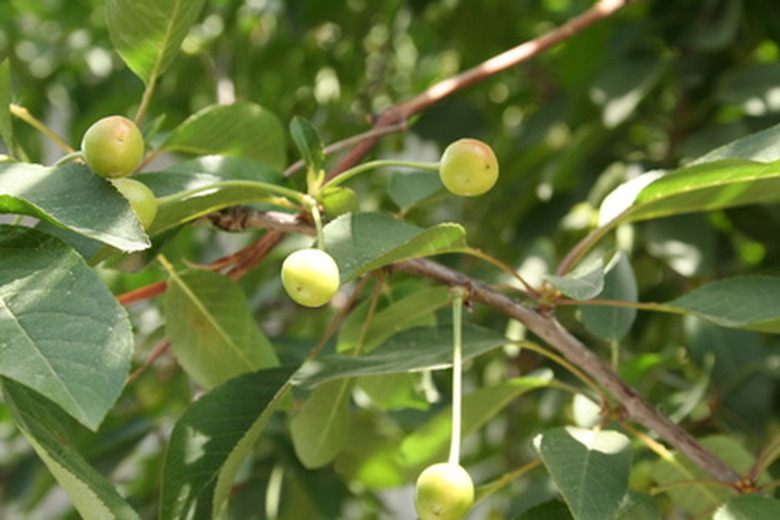How To Grow Cherry Trees In North Carolina
Things Needed
- pH test kit
- Lime (optional)
- Sulfur (optional)
- Shovel
- Water
- Anvil pruners
- 10-10-10 fertilizer
North Carolina gardeners can grow either sweet cherries or sour cherries, depending on their location. To properly ripen, cherries need both sufficient winter chill (or temperatures below freezing) and temperate spring and summer weather; North Carolina provides both temperature extremes. Tart cherries are ideal for baking into pies or preserves, while sweet cherries can be eaten fresh or cooked. Plant a cherry tree in the spring, selecting either a bare root cherry tree or a container cherry tree that's 1 to 2 years old.
Step 1
Find your USDA hardiness zone using the state map from Grow It (see Resources). North Carolina fits in zones 6b to 8. Gardeners in zone 6b can plant either sweet or tart cherry trees. Those in zones 6b or 7 can grow sweet cherries, and those in zone 8 cannot grow cherry trees reliably since they don't receive enough winter chill hours.
- North Carolina gardeners can grow either sweet cherries or sour cherries, depending on their location.
Step 2
Test the pH in your yard using a home test kit, or contact your local county extension office to get a soil sample taken. Cherries prefer a soil pH of 6.2 to 6.8, or slightly acidic.
Step 3
Amend your pH to this preferred range by using lime to raise it or sulfur to lower it. See The Garden Helper's chart for how much of these materials to use based on your soil type (see Resources).
Step 4
Dig a hole for your cherry tree that's twice the size of the rootball. Remove rocks and weeds from the hole. Pull your cherry tree from its container. Break apart the rootball with your hands and untangle tangled roots.
- Test the pH in your yard using a home test kit, or contact your local county extension office to get a soil sample taken.
Step 5
Place the cherry tree in the hole so it sits at the same depth as it was planted in the container. Hold the tree trunk straight with one hand and backfill the soil with soil. Gently firm the soil around the tree trunk.
Step 6
Water the newly planted tree using 2 gallons of water. The ground becomes saturated and the soil compresses around the tree trunk.
Step 7
Prune the newly planted tree to a height of 24 inches.
Step 8
Continue to water your cherry tree, providing 1 inch of water every two weeks, unless you receive sufficient rainfall.
- Place the cherry tree in the hole so it sits at the same depth as it was planted in the container.
- Hold the tree trunk straight with one hand and backfill the soil with soil.
Step 9
Fertilize the young tree two weeks after planting and again six weeks after planting using 1/2 lb. of 10-10-10 fertilizer. Scatter the fertilizer on the ground around the tree then water the soil to work the nutrients in.
Step 10
Prune the tree to shape it the spring after planting. Select three to four strong outward growing limbs to be fruit bearing limbs and remove competing limbs that grow too close to the trunk or are weak. Remove suckers growing from the trunk.
Step 11
Fertilize the tree annually thereafter with 0.05 or 0.10 lbs. of nitrogen fertilizer per inch of cherry tree trunk diameter.
- Fertilize the young tree two weeks after planting and again six weeks after planting using 1/2 lb.
- Prune the tree to shape it the spring after planting.
